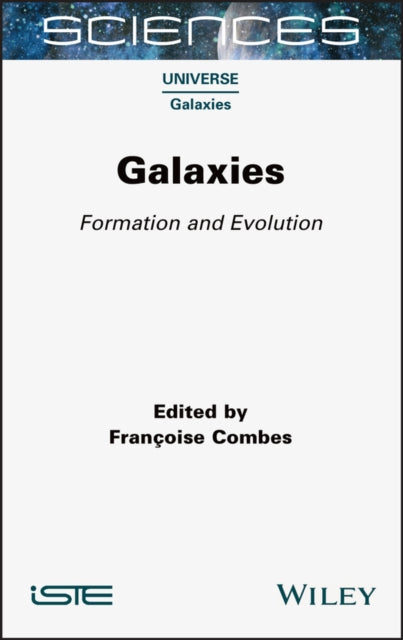Shulph Ink
Galaxies: Formation and Evolution
Galaxies: Formation and Evolution
YOU SAVE £13.67
- Condition: Brand new
- UK Delivery times: Usually arrives within 2 - 3 working days
- UK Shipping: Fee starts at £2.39. Subject to product weight & dimension
Bulk ordering. Want 15 or more copies? Get a personalised quote and bigger discounts. Learn more about bulk orders.
Couldn't load pickup availability
- More about Galaxies: Formation and Evolution
Galaxies are vast collections of stars, gas, and dust held together by dark matter halos. They come in various shapes and forms and are classified based on their characteristics. Galaxies spend most of their lives in the blue cloud, forming stars, before transitioning to the red sequence as spheroids. This transformation is likely due to galaxy interactions or the feedback of active nuclei, driven by the energy released by super-massive black holes. Galaxies is a comprehensive book that explores these topics in depth, written by experts in the field.
Format: Hardback
Length: 288 pages
Publication date: 07 May 2021
Publisher: ISTE Ltd
Galaxies are vast celestial structures composed of stars, gas, and dust, intricately intertwined with dark matter halos. They serve as the fundamental units of the universe, aggregated into groups, clusters, and superclusters. These celestial entities manifest in diverse forms, ranging from spheroids to disks. Classification systems, such as the Hubble sequence and the colormagnitude diagram, aid in comprehending their formation and evolution. Galaxies spend a significant portion of their existence within the blue cloud, where they undergo the process of star formation as spiral or dwarf galaxies. However, a mysterious mechanism causes them to cease star formation and transition into the red sequence, evolving into spheroids. The underlying causes of this transformation remain largely unexplained, but they may be attributed to galaxy interactions or the feedback of active nuclei, driven by the energy released by their central super-massive black holes. These intricate mechanisms offer insights into the history of cosmic star formation, which was notably more active in the early stages of the universe's existence.
Galaxies, celestial wonders, encompass a mesmerizing tapestry of stars, gas, and dust, intricately woven within dark matter halos. They stand as the cornerstone of the universe, gathered into clusters, superclusters, and vast assemblages. These celestial entities manifest in a myriad of shapes, from spheroids to disks, each carrying its unique characteristics. Classification systems, like the Hubble sequence and the colormagnitude diagram, serve as valuable tools in unraveling the mysteries of their formation and evolution. Galaxies embark on a remarkable journey within the blue cloud, where they nurture the birth of stars through the process of spiral or dwarf galaxy formation. However, a profound transformation awaits them as they gracefully transition into the red sequence, evolving into spheroids. The underlying mechanisms behind this remarkable shift remain largely enigmatic, but they may be linked to intricate galaxy interactions or the enigmatic feedback of active nuclei, propelled by the energy emanating from their central super-massive black holes. These intricate processes offer profound insights into the history of cosmic star formation, which unfolded with remarkable vigor in the early stages of the universe's existence.
Galaxies, celestial marvels, encompass a vast expanse of stars, gas, and dust, intricately intertwined with dark matter halos. They serve as the fundamental building blocks of the universe, aggregated into clusters, superclusters, and vast assemblages. These celestial entities manifest in diverse forms, ranging from spheroids to disks, each carrying its unique characteristics. Classification systems, such as the Hubble sequence and the colormagnitude diagram, provide valuable insights into their formation and evolution. Galaxies embark on a remarkable journey within the blue cloud, where they nurture the birth of stars through the process of spiral or dwarf galaxy formation. However, a profound transformation awaits them as they gracefully transition into the red sequence, evolving into spheroids. The underlying mechanisms behind this remarkable shift remain largely enigmatic, but they may be linked to intricate galaxy interactions or the enigmatic feedback of active nuclei, propelled by the energy emanating from their central super-massive black holes. These intricate processes offer profound insights into the history of cosmic star formation, which unfolded with remarkable vigor in the early stages of the universe's existence.
Weight: 546g
Dimension: 253 x 166 x 21 (mm)
ISBN-13: 9781789450125
This item can be found in:
UK and International shipping information
UK and International shipping information
UK Delivery and returns information:
- Delivery within 2 - 3 days when ordering in the UK.
- Shipping fee for UK customers from £2.39. Fully tracked shipping service available.
- Returns policy: Return within 30 days of receipt for full refund.
International deliveries:
Shulph Ink now ships to Australia, Belgium, Canada, France, Germany, Ireland, Italy, India, Luxembourg Saudi Arabia, Singapore, Spain, Netherlands, New Zealand, United Arab Emirates, United States of America.
- Delivery times: within 5 - 10 days for international orders.
- Shipping fee: charges vary for overseas orders. Only tracked services are available for most international orders. Some countries have untracked shipping options.
- Customs charges: If ordering to addresses outside the United Kingdom, you may or may not incur additional customs and duties fees during local delivery.


